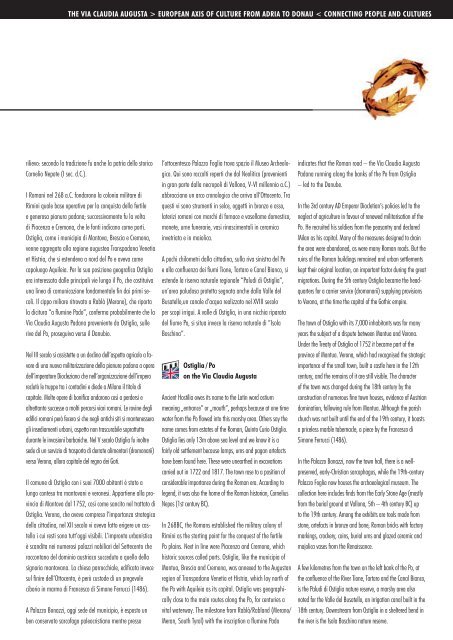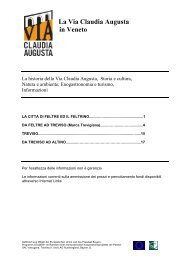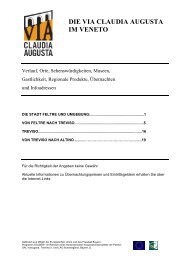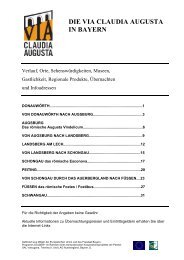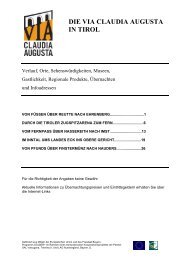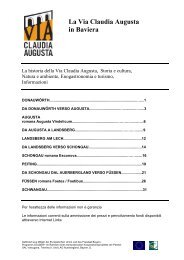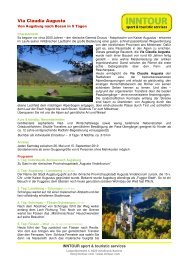VIA CLAUDIA AUGUSTA SALESGUIDE
VIA CLAUDIA AUGUSTA SALESGUIDE
VIA CLAUDIA AUGUSTA SALESGUIDE
You also want an ePaper? Increase the reach of your titles
YUMPU automatically turns print PDFs into web optimized ePapers that Google loves.
The ViA ClAudiA AugusTA > eurOPeAn Axis Of CulTure frOm AdriA TO dOnAu < COnneCTing PeOPle And CulTures<br />
rilievo: secondo la tradizione fu anche la patria dello storico<br />
Cornelio Nepote (I sec. d.C.).<br />
I Romani nel 268 a.C. fondarono la colonia militare di<br />
Rimini quale base operativa per la conquista della fertile<br />
e generosa pianura padana; successivamente fu la volta<br />
di Piacenza e Cremona, che le fonti indicano come porti.<br />
Ostiglia, come i municipia di Mantova, Brescia e Cremona,<br />
venne aggregata alla regione augustea Transpadana Venetia<br />
et Histria, che si estendeva a nord del Po e aveva come<br />
capoluogo Aquileia. Per la sua posizione geografica Ostiglia<br />
era interessata dalle principali vie lungo il Po, che costituiva<br />
una linea di comunicazione fondamentale fin dai primi secoli.<br />
Il cippo miliare ritrovato a Rablà (Merano), che riporta<br />
la dicitura “a flumine Pado”, conferma probabilmente che la<br />
Via Claudia Augusta Padana proveniente da Ostiglia, sulle<br />
rive del Po, proseguiva verso il Danubio.<br />
Nel III secolo si assistette a un declino dell’aspetto agricolo a favore<br />
di una nuova militarizzazione della pianura padana a opera<br />
dell’imperatore Diocleziano che nell’organizzazione dell’impero<br />
reclutò le truppe tra i contadini e diede a Milano il titolo di<br />
capitale. Molte opere di bonifica andarono così a perdersi e<br />
altrettanto successe a molti percorsi viari romani. Le rovine degli<br />
edifici romani però fecero sì che negli antichi siti si mantenessero<br />
gli insediamenti urbani, aspetto non trascurabile soprattutto<br />
durante le invasioni barbariche. Nel V secolo Ostiglia fu inoltre<br />
sede di un servizio di trasporto di derrate alimentari (dromonarii)<br />
verso Verona, allora capitale del regno dei Goti.<br />
Il comune di Ostiglia con i suoi 7000 abitanti è stato a<br />
lungo conteso tra mantovani e veronesi. Appartiene alla provincia<br />
di Mantova dal 1752, così come sancito nel trattato di<br />
Ostiglia. Verona, che aveva compreso l’importanza strategica<br />
della cittadina, nel XII secolo vi aveva fatto erigere un castello<br />
i cui resti sono tutt’oggi visibili. L’impronta urbanistica<br />
è scandita nei numerosi palazzi nobiliari del Settecento che<br />
raccontano del dominio austriaco succeduto a quello della<br />
signoria mantovana. La chiesa parrocchiale, edificata invece<br />
sul finire dell’Ottocento, è però custode di un pregevole<br />
ciborio in marmo di Francesco di Simone Ferrucci (1486).<br />
A Palazzo Bonazzi, oggi sede del municipio, è esposto un<br />
ben conservato sarcofago paleocristiano mentre presso<br />
l’ottocentesco Palazzo Foglia trova spazio il Museo Archeologico.<br />
Qui sono raccolti reperti che dal Neolitico (provenienti<br />
in gran parte dalla necropoli di Vallona, V-VI millennio a.C.)<br />
abbracciano un arco cronologico che arriva all’Ottocento. Tra<br />
questi vi sono strumenti in selce, oggetti in bronzo e osso,<br />
laterizi romani con marchi di fornace e vasellame domestico,<br />
monete, urne funerarie, vasi rinascimentali in ceramica<br />
invetriata e in maiolica.<br />
A pochi chilometri dalla cittadina, sulla riva sinistra del Po<br />
e alla confluenza dei fiumi Tione, Tartaro e Canal Bianco, si<br />
estende la riserva naturale regionale “Paludi di Ostiglia”,<br />
un’area paludosa protetta segnata anche dalla Valle del<br />
Busatello,un canale d‘acqua realizzato nel XVIII secolo<br />
per scopi irrigui. A valle di Ostiglia, in una nicchia riparata<br />
del fiume Po, si situa invece la riserva naturale di “Isola<br />
Boschina”.<br />
Ostiglia / Po<br />
on the Via Claudia Augusta<br />
Ancient Hostilia owes its name to the Latin word ostium<br />
meaning „entrance“ or „mouth“, perhaps because at one time<br />
water from the Po flowed into this marshy area. Others say the<br />
name comes from estates of the Roman, Quinto Curio Ostiglio.<br />
Ostiglia lies only 13m above sea level and we know it is a<br />
fairly old settlement because lamps, urns and pagan artefacts<br />
have been found here. These were unearthed in excavations<br />
carried out in 1722 and 1817. The town rose to a position of<br />
considerable importance during the Roman era. According to<br />
legend, it was also the home of the Roman historian, Cornelius<br />
Nepos (1st century BC).<br />
In 268BC, the Romans established the military colony of<br />
Rimini as the starting point for the conquest of the fertile<br />
Po plains. Next in line were Piacenza and Cremona, which<br />
historic sources called ports. Ostiglia, like the municipia of<br />
Mantua, Brescia and Cremona, was annexed to the Augustan<br />
region of Transpadana Venetia et Histria, which lay north of<br />
the Po with Aquileia as its capital. Ostiglia was geographically<br />
close to the main routes along the Po, for centuries a<br />
vital waterway. The milestone from Rablà/Rabland (Merano/<br />
Meran, South Tyrol) with the inscription a flumine Pado<br />
indicates that the Roman road – the Via Claudia Augusta<br />
Padana running along the banks of the Po from Ostiglia<br />
– led to the Danube.<br />
In the 3rd century AD Emperor Diocletian‘s policies led to the<br />
neglect of agriculture in favour of renewed militarisation of the<br />
Po. He recruited his soldiers from the peasantry and declared<br />
Milan as his capital. Many of the measures designed to drain<br />
the area were abandoned, as were many Roman roads. But the<br />
ruins of the Roman buildings remained and urban settlements<br />
kept their original location, an important factor during the great<br />
migrations. During the 5th century Ostiglia became the headquarters<br />
for a carrier service (dromonarii) supplying provisions<br />
to Verona, at the time the capital of the Gothic empire.<br />
The town of Ostiglia with its 7,000 inhabitants was for many<br />
years the subject of a dispute between Mantua and Verona.<br />
Under the Treaty of Ostiglia of 1752 it became part of the<br />
province of Mantua. Verona, which had recognised the strategic<br />
importance of the small town, built a castle here in the 12th<br />
century, and the remains of it are still visible. The character<br />
of the town was changed during the 18th century by the<br />
construction of numerous fine town houses, evidence of Austrian<br />
domination, following rule from Mantua. Although the parish<br />
church was not built until the end of the 19th century, it boasts<br />
a priceless marble tabernacle, a piece by the Francesco di<br />
Simone Ferrucci (1486).<br />
In the Palazzo Bonazzi, now the town hall, there is a wellpreserved,<br />
early-Christian sarcophagus, while the 19th-century<br />
Palazzo Foglia now houses the archaeological museum. The<br />
collection here includes finds from the Early Stone Age (mostly<br />
from the burial ground at Vallona, 5th – 4th century BC) up<br />
to the 19th century. Among the exhibits are tools made from<br />
stone, artefacts in bronze and bone, Roman bricks with factory<br />
markings, crockery, coins, burial urns and glazed ceramic and<br />
majolica vases from the Renaissance.<br />
A few kilometres from the town on the left bank of the Po, at<br />
the confluence of the River Tione, Tartaro and the Canal Bianco,<br />
is the Paludi di Ostiglia nature reserve, a marshy area also<br />
noted for the Valle del Busatello, an irrigation canal built in the<br />
18th century. Downstream from Ostiglia in a sheltered bend in<br />
the river is the Isola Boschina nature reserve.


